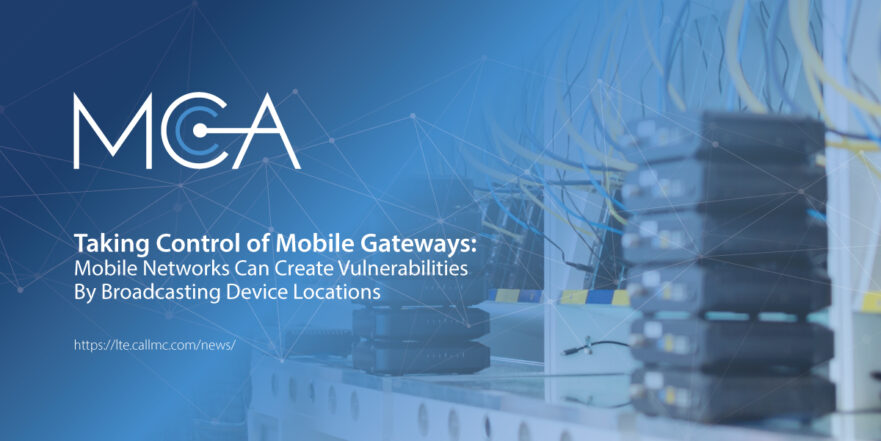Mobile Networks Can Create Vulnerabilities By Broadcasting Device Locations
Effectively overseeing a vital mobile workforce presents its own set of obstacles. It necessitates the utilization of wireless technology and management frameworks to guarantee constant accessibility for employees, regardless of location - be it in transit, stationed in vehicles, or deployed at remote or temporary work sites, such as those of First Responders. As the conduits overseeing and interpreting the whereabouts and conditions of these mobile assets, 4G/5G LTE mobile gateways play a crucial role. However, ensuring their proper protection is paramount, as overlooking this aspect could lead to significant security vulnerabilities.
At the Black Hat conference in August 2018, one particularly crowded session was titled "Snooping on Cellular Gateways and Their Critical Role in ICS.” The presentation garnered significant interest from attendees as it delved into recent security vulnerability research conducted by the organization. This research revealed a startling discovery: over 100,000 Internet-facing mobile cellular gateways regularly broadcast their precise locations to the world. Among these vulnerable devices are fleet vehicles, police cars, and ambulances, making them susceptible targets for hackers and various attacks.
The presentation also outlined potential real-world scenarios that could exploit these vulnerabilities, emphasizing the severity of the issue. However, the research offered reassurance that such vulnerabilities could be mitigated with the implementation of a few best practices. Regrettably, awareness of these solutions is lacking.
Despite the continuous stream of warnings regarding the exposure of this equipment, they largely go unnoticed by many.
Vehicle Router Misconfigurations Can Lead To Network Vulnerability
The crux of the problem lies in misconfigurations that are exploited due to end users neglecting best practices in securing their mobile assets - specifically, the routers within each vehicle. Misconfigurations arise from deficient configuration management capabilities, inadequate default password designs, the absence of policies to curtail remote management, and the lack of a centralized management platform to oversee the entire process.
Misconfigurations are bound to occur without centralized configuration and mobile network infrastructure patch management, creating vulnerabilities that hackers can exploit within your network. This underscores the critical necessity of implementing centralized configuration and patch management procedures to fortify the security of mobile assets effectively.
Implementing Best Practices Helps Eliminate Mobile Network Weaknesses
In addition to rectifying misconfigurations, adherence to best practices is imperative for securing mobile networks. Here are some common best practices to bolster the security of mobile 4G/5G LTE-enabled gateways:
Utilize Private IP Networks
Implement access control lists (ACLs)
Employ firewall policies
Enforce strong password policies
Leverage authentication services
Utilize encrypted VPNs
While the best practices outlined are not groundbreaking and are commonly employed for securing wireline network infrastructure, it's worth noting that the teams responsible for deploying and managing mobile networks may not always overlap with those managing other enterprise infrastructure. Consequently, this can lead to potential gaps in controls and governance.
Additionally, the maturity level of various mobile gateway vendors in terms of configuration management and security capabilities may sometimes lag behind that of wireline network infrastructure.
For those operating a mobile network or contemplating its deployment, thoroughly examining management platform capabilities in collaboration with the network operations team is paramount. Opting for a cloud-based management platform can streamline the complexities of mobile configurations while adhering to best practices, reducing the likelihood of errors and vulnerabilities. Such platforms also facilitate swift responses to patching vulnerabilities.
For instance, when the Heartbleed bug was disclosed, Cradlepoint deployed a global fix for all customers within seven days, demonstrating the agility and efficacy of cloud-based solutions in promptly addressing security concerns.
If an organization has an extremely low risk tolerance, exploring various private network options for WAN connectivity could be advantageous. This includes utilizing wireless carrier private networks or adopting "zero trust" private network overlays that leverage Software-Defined Perimeter (SDP) technology, such as Cradlepoint’s NetCloud Perimeter. These private network solutions shield gateways and their associated devices from direct exposure to Internet-based attacks while facilitating secure remote access.
Additionally, it's beneficial to consider specialized mobile LTE gateways that support Federal Information Processing Standard (FIPS) 140-2 Inside security validation. These gateways feature cryptographic modules rigorously tested by third parties, ensuring compliance with security standards mandated by the U.S. government.
Incorporating an integrated Intrusion Prevention Engine (IPS) for mobile gateway deployments can provide an additional layer of defense against evolving malware threats, aligning with recommendations outlined in the Criminal Justice Information Standard (CJIS) Security Policy Guidelines.
About MCA and Our CNS Team
MCA is one of the largest and most trusted integrators in the United States, offering world-class voice, data, and security solutions that enhance the quality, safety, and productivity of customers, operations, and lives. More than 65,000 customers trust MCA to provide carefully researched solutions for a safe, secure, and more efficient workplace.
Our Cellular Networking Solutions (CNS) team (formerly known as USAT) is made up of certified experts in designing and deploying fixed and mobile wireless data connectivity solutions for public and private enterprises nationwide - complete with implementation, training, proof of concept (POC), system auditing, and on-site RF surveying services with optional engineering maintenance contracts.
Our extensive catalog of world-class routers, gateways, and software designed for remote monitoring and management in even the harshest environments allows us to deliver a full suite of reliable technologies capped with a service-first approach.
Share this Post














